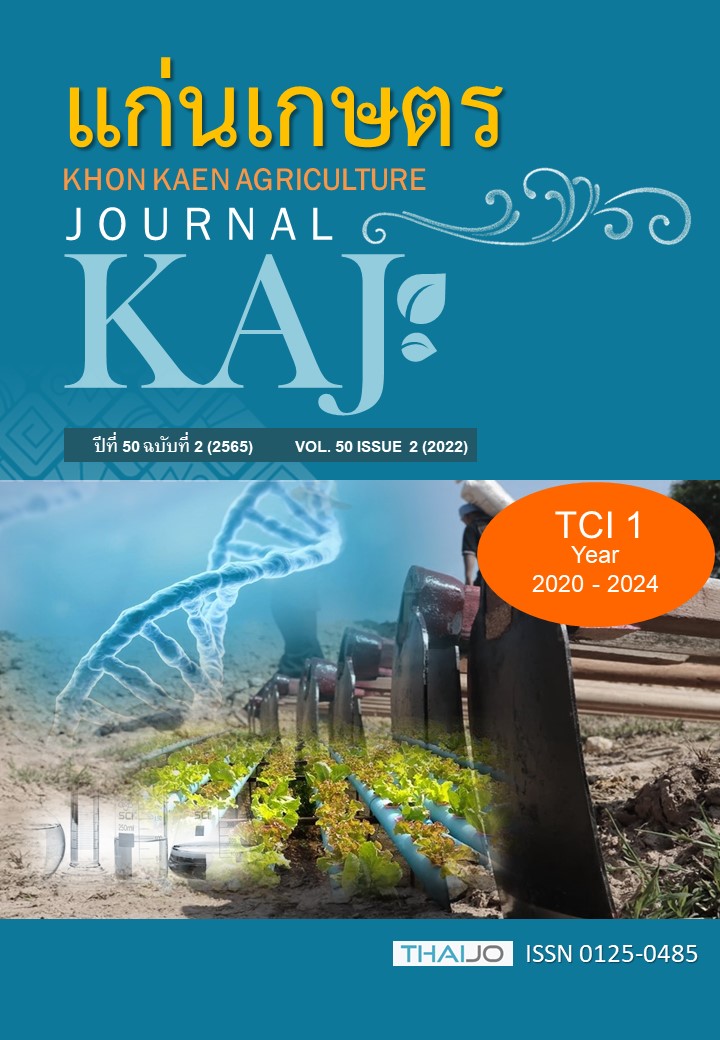ภาวะการดื้อยาปฏิชีวนะของเชื้อ Escherichia coli ในเนื้อไก่ในเขตพื้นที่อำเภอเมือง จังหวัดมหาสารคาม
Main Article Content
บทคัดย่อ
บทคัดย่อ: Escherichia coli เป็นแบคทีเรียประจำถิ่นในระบบทางเดินอาหารของสัตว์เลือดอุ่นที่พบพฤติกรรมดื้อยาต้านจุลชีพที่เป็นปัญหาทั่วโลก งานวิจัยครั้งนี้มีวัตถุประสงค์เพื่อศึกษาการดื้อต่อยาปฏิชีวนะจำนวน 4 ชนิด คือ enrofloxacin, amoxicillin, doxycycline และ colistin ของเชื้อ E. coli ที่ปนเปื้อนในเนื้อไก่สดจาก 25 แหล่งจำหน่าย ได้แก่ ตลาดสด 20 แห่ง ห้างสรรพสินค้า 3 แห่ง และร้านค้าปลีก 2 แห่ง ในเขตพื้นที่อำเภอเมือง จังหวัดมหาสารคาม ผลการทดลอง พบว่า มีการตรวจพบการปนเปื้อนของเชื้อ E. coli จากแหล่งจำหน่ายที่เป็นตลาดสดจำนวน 12 แห่ง แต่ไม่พบการปนเปื้อนจากแหล่งจำหน่ายที่เป็นห้างสรรพสินค้าและร้านค้าปลีก และไม่พบการตกค้างของยาปฏิชีวนะในเนื้อไก่จากทุกแหล่งจำหน่าย เมื่อทดสอบการดื้อต่อยาปฏิชีวนะของเชื้อ E. coli ตามอัตราการเกิด clear zone พบว่า เชื้อ E. coli ที่ตรวจพบในเนื้อไก่สดจากแหล่งจำหน่ายที่เป็นตลาดสดดื้อต่อยาปฏิชีวนะชนิด amoxicillin สูงที่สุด รองลงมา คือ enrofloxacin, doxycycline และ colistin โดยความไวต่อยาปฏิชีวนะของเชื้อ E. coli ที่ตรวจพบ คิดเป็น 83.33, 33.33, 25.00 และ 16.67 เปอร์เซ็นต์ ตามลำดับ
คำสำคัญ: เชื้อ Escherichia coli, เนื้อไก่, เชื้อดื้อยา, ยาปฏิชีวนะ
Article Details

อนุญาตภายใต้เงื่อนไข Creative Commons Attribution-NonCommercial-NoDerivatives 4.0 International License.
เอกสารอ้างอิง
กมลสิริ ภูมิภมร ประภัสสร เชาวนสกุล ประสบพร ทองนุ่น และอัญญรัตน์ ทิพย์ธารา. 2560. ความไวรับต่อยาต้านจุลชีพของเชื้อ Escherichia coli และ Enterococcus spp. และยีนดื้อยาที่พบในมูลสุกร ระหว่างฟาร์มที่มีระบบ การเลี้ยงปกติ และฟาร์มกึ่งอินทรีย์. วารสารสถาบันสุขภาพสัตว์แห่งชาติ. 12: 103-137.
กฤติกา ดำมุณี. 2558. ลักษณะการดื้อยาปฏิชีวนะ Escherichia coli ที่แยกได้จากเด็กที่เป็นมะเร็งในโรงพยาบาลสงขลานครินทร์. วิทยานิพนธ์ ปริญญาวิทยาศาสตรมหาบัณฑิต มหาบัณฑิต มหาวิทยาลัยสงขลานครินทร์. สงขลา.
ณัฐธิดา สุข, ณัฐพร รัฐบำรุง, พักตร์วิภา สุวรรณพรหม และหทัยการญจน์ เชาพูนผล. 2559. การใช้ยาปฏิชีวนะในฟาร์มปศุสัตว์ กรณีศึกษาจังหวัดเชียงใหม่. คณะเภสัชศาสตร์ มหาวิทยาลัยเชียงใหม่, เชียงใหม่.
นิธิมา สุ่มประดิษฐ์, ศิริตรี สุทธจิตต์, สิตานันท์ ภูผลทรัพย์, รุ่งทิพย์ ชวนชื่น และภูษิต ประคองสาย. 2558. สถานการณ์เชื้อดื้อยาต้านจุลชีพในปศุสัตว์ ใน: เอกสารการประชุม เรื่อง สถานการณ์และการจัดการการดื้อยาต้านจุลชีพในประเทศไทย. กระทรวงสาธารณสุข. สำนักพิมพ์อักษรกราฟฟิกและดีไซน์. กรุงเทพมหานคร.
เนตรชนก จิวากานนท์ สุจิตราภรณ์ ลิมาภิรักษ์ และชุลีรัตน์ สร้อยสุวรรณ์. 2551. การสำรวจการดื้อ ยาต้านจุลชีพของเชื้อ Escherichia coli จากอุจจาระไก่และสุกรในภาคตะวันออกเฉียงเหนือตอนบน. วารสารสถาบันสุขภาพสัตว์แห่งชาติ. 2: 118-129.
พนาวรรณ คุณติสุข. 2554. การใช้ยาปฏิชีวนะ (Antibiotic drugs) อย่างถูกต้องและเหมาะสม. วารสารโลหิตวิทยาและเวชศาสตร์บริการโลหิต. 21: 193-195
วรางคณา ไชยซาววงษ์, ชุลีพร ศักดิ์สง่าวงษ์, รวิศา วรินทร์, รัชฎาพร บริพันธุ์, จำรัส เลิศศรี และมนทิรา อินต๊ะนอน. 2561. ประสิทธิภาพของชุดทดสอบยาต้านจุลชีพตกค้างในเนื้อสัตว์โดยใช้หลักการยับยั้งเชื้อจุลชีพ. เชียงใหม่สัตวแพทยสาร. 16: 27-36.
วิษณุ ธรรมลิขิตกุล. 2551. โคลิสติน: ยาต้านจุลชีพสำหรับรักษาโรคติดเชื้อแบคทีเรียกรัมลบดื้อยา. เวชบันทึกศิริราช. 1: 152-158.
วิษณุ ธรรมลิขิตกุล. 2557. เชื้อโรคดื้อยาปฏิชีวนะ (ยาต้านจุลชีพ) และการควบคุมและป้องกันโรคติดเชื้อดื้อยาปฏิชีวนะ. เวชบันทึกศิริราช. 7: 26-29.
ศุภชัย เนื้อนวลสุวรรณ. 2549. ความปลอดภัยของอาหาร (Food Safety) พิมพ์ครั้งที่ 1. Sister Print and Media Group. กรุงเทพมหานคร.
สำนักงานมาตรฐานสินค้าเกษตรและอาหารแห่งชาติ. 2547. ปัญหายาตกค้างในเนื้อสัตว์และแนวทางแก้ไข. โรงพิมพ์องค์การสงเคราะห์ทหารผ่านศึก. กรุงเทพมหานคร.
สุรางค์ เดชศิริเลิศ และ อรทัย ทองมะลิ. 2555. ภาพรวมสถานการณ์เชื้อดื้อยาในประเทศไทย. สถานการณ์เชื้อดื้อยาและปัญหาการใช้ยาปฏิชีวนะ. พิมพ์ครั้งที่ 1. แผนงานสร้างกลไกลเฝ้าระวังและพัฒนาระบบยา. กรุงเทพมหานคร.
อรรถพล ตันไสว และพรรณนิกา ฤตวิรุฬห์. 2557. อุบัติการณ์และคุณสมบัติของเชื้อเอสเชอริเชียโคไลดื้อยาหลายขนานในเนื้อสัตว์ปีก. วารสารมหาวิทยาลัยนเรศวร: วิทยาศาสตร์และเทคโนโลยี. 22: 40-47.
Bacteriogical Analytical Manual (BAM). 2001.Enumeration of Total Bacteria. Available: https://www.fda.gov/food/laboratory-methods-food/bacteriological-analytical-manual-bam. Accessed Nov. 20, 2020.
Bacteriogical Analytical Manual (BAM). 2002. Enumeration of Escherichia coli and the Coliform Bacteria. Available: https://www.fda.gov/food/laboratory-methods-food/bam-chapter-4-enumeration-escherichia-coli-and-coliform-bacteria. Accessed Nov. 20, 2020.
Berendsen, B. J. A, J. Lahr, C. Nibbeling, L. J. M.Jansen, I. E. A. Bongers, E. L. Wipfler, and M. G. M. Schans. 2018. The persistence of a broad range of antibiotics during calve, pig and broiler manure storage. Chemosphere. 204: 267-276.
Centers for Disease Control and Prevention (CDC). 2013. Antibiotics and food-producing animals. Available: www.cdc.gov/narms/faq.html. Accessed November 20, 2020.
Chaisatit, C., C. Tribuddharat, C. Pulsrikarn, and S. Dejsirilert. 2012. Molecular characterization of antibiotic-resistant bacteria in contaminated chicken meat sold at supermarkets in Bangkok, Thailand. Japanese Journal of Infectious Diseases 65: 527-534.
Clinical and Laboratory Standards Institute. 2008. Performance standards for antimicrobial susceptibility disk and dilution susceptibility tests bacteria isolated from animals; Approved Standard 3rd ed. Vol. 28 No. 8. Pennsylvania, USA. p. 1-75.
Codex Alimentarius Commission. 2018. Maximum Residue Limits (MRLs) and Risk Management Recommendations (RMRs) for residues of veterinary drugs in foods. Available: http://www.fao.org/fao-who-codexalimentarius/codex-texts/maximum-residue-limits/en/.Accessed November 20, 2020.
Consumers Union. 2015. The overuse of antibiotics in food animals threatens public health. Available: https://advocacy.consumerreports.org/. Accessed November 20, 2020.
European Food Safety Authority (EFSA). 2012. Technical specifications on the harmonized monitoring and reporting of antimicrobial resistance in Salmonella, Campylobacter and indicator Escherichia coli and Enterococcus spp. bacteria transmitted through food. European Food Safety Authority Journal. 10(6): 2742-2806.
European communities. 2002. Commission Decision 2002/657/EC of 12 August 2002 implementing Council Directive 96/23/EC concerning the performance of analytical methods and the interpretation of results. Official Journal of the European Communities. L221: 8-36.
European Commission. 2009. Commission Regulation (EU) No 37/2010 of 22 December 2009 on Pharmacologically active substances and their classification regarding maximum residue limits in foodstuffs of animal origin. Official Journal of the European Union L. 15: 1-72.
Falagas, M. E., and S. K. Kasiakou. 2005. Colistin: the revival of Polymyxins for the management of multidrug-resistant gram-negative bacterial infections. Reviews of Anti-infective Agents. 40: 1333-1340.
Food and Drug Administration. 2019. FDA approves new treatment for complicated urinary tract and complicated intra-abdominal infections. Available: https://www.fda.gov/news-events/press-announcements/fda-approves-new-treatment-complicated-urinary-tract-and-complicated-intra-abdominal-infections. Accessed November 20, 2020.
Japan Food Chemical Research Foundation. 2011. Table of MRLs for agricultural chemicals, colistin. Maximum Residue Limits (MRLs) List of Agricultural Chemicals in Foods. Available: https://db.ffcr.or.jp /front/pesticidedetail?id=23900. Accessed November 20, 2020.
Johnson, J. R., M. A. Kuskowski, M. Menard, A. Gajewski, M. Xercavins, and J. Garau. 2006. Similarity between human and chicken Escherichia coli isolates in relation to ciprofloxacin resistancestatus. Journal of Infectious Diseases. 1: 71-78.
Lee, G. Y., H. I. Jang, I. G. Hwang, and M. S. Rhee. 2009. Prevalence and classification of pathogenic Escherichia coli isolated from fresh beef poultry, and pork in Korea. International Journal of Food Microbiology 134: 196-200.
Liu, Y. Y., Y. Wang, T. R. Walsh, L. X. Yi, R. Zhang, J. Spencer, Y. Doi, G. Tian, B. Dong, and X. Huang. 2015. Emergence of plasmid-mediated colistin resistance mechanism MCR-1 in animals and human beings in China: a microbiological and molecular biological study. The Lancet infectious diseases. 16: 161-168.
Overdevest, I., I. Willemsen, M. Rijnsburger, A. Eustace, I. Xu, P. Hawkey, M. Heck, P. Savelkoul, C. Vandenbroucke-Grauls, K. van der Zwaluw, X. Huijsdens, and J. Kluytmans. 2011. Extended spectrum beta-lactamase genes of Escherichia coli in chicken meat and humans, the Netherlands. Emergence Infectious Diseases. 17: 1216-1222.
Statistical Analysis System. 2002. User’s Guide: Statistic. Version 9ed. SAS. Inst. Cary, NC, U.S.A.
Seiffert, S. N., M. Hilty, V. Perreten, and E. Ndimiani. 2013. Extended-spectrum cephalosporin-resistant gram-negative organisms in livestock: An emerging problem for human health. Drug Resistance. Updates. 16: 22-45.


